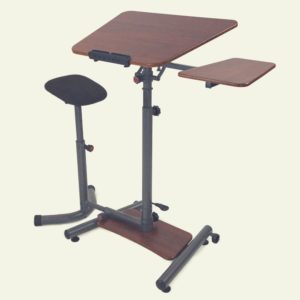If you are recovering from a knee injury, suffer from knee pain, or perhaps are just
simply interested in preserving your joints during exercise, then you may be wondering, what are the best exercises for low impact on the knees?
In a nutshell, the best exercises for low impact on knees are any moves that won’t worsen the condition or cause inflammation, swelling, and pain. And just because they are easier on the joints doesn’t mean you won’t also be able to still burn calories to stay fit or lose weight.
What Makes Low-Impact Exercises the Best for Your Knees?
High impact exercise typically requires some type of jumping or propelling motion, jumping or jarring motion, which can exert more than twice your body weight in pressure on your joints, tendons, and ligaments.
Therefore, it is not uncommon for many people of all ages and fitness levels to at some point experience some degree of knee pain after committing to a high-impact workout routine. However, after all your devotion to your program and finally seeing results, the last thing you want to do is cease exercising.
But if you are suddenly faced with pain, an injury, or inflammatory joint disease, such as arthritis, continuing to participate in high-impact exercise can only make it worse.
Low-impact exercise, on the other hand, puts little to no force on the body’s weight-bearing parts, so it is gentle enough for those with injured or painful joints.
In fact, many physicians recommend their patients engage in low-impact exercise to help keep them active but without irritating or damaging the knees.
A study published in the US National Library of Medicine involving osteoarthritis patients shows that exercise is even good for alleviating knee pain as compared to doing nothing at all.
However, if you have knee issues, before participating in any low-impact exercise, it is important to get the okay from your physical therapist or doctor that it is suitable for your condition.
In some cases, they may even recommend some adjustments you can make to the exercises to help make them more appropriate for you.
What Are the Best Exercises for Low Impact on Knees?
Various experts agree that the best exercises for low impact on knees are gentle lower body stretches, especially following an injury or surgery, because they increase joint flexibility for improved mobility to better perform other exercises and physical activities.
They can also be used after strengthening exercises to help prevent soreness and stiffness post-workout.
Some lower body stretches for the knees include:
- Heel Cord Stretches
- Supine Hamstring Stretches
- Standing Quad Stretches
- Calf Stretches
- Knee Straighteners
Before stretching, it is recommended you first begin with a light warm-up, such as a 5-minute brisk walk, to help prepare your muscles to stretch with ease.
Do Low-Impact Exercises Help Strengthen Your Knees?
Doctors state that low-impact strengthening exercises help build and tone the connective tissues surrounding the knees, which helps them better absorb impact, so they function properly and without pain.
Some Orthopedic recommended strengthening exercises to help reinforce the knee joint include:
- Calf Raises
- Half Squats
- Leg Extensions
- Hamstring Curls
- Hip Abductions
- Straight Leg Raises
- Leg Presses
Once you become accustomed to performing these exercises, they state that you can also slowly increase the resistance by adding light hand or ankle weights for added strengthening. Or you could also use a weight machine to perform many of the moves.

What Are the Best Low-Impact Cardio Exercises for the Knees?
During low-impact cardio exercises, at least one foot remains on the ground at all times; hence, they are all good for the knees.
Some examples of low-impact cardio include:
- Cycling
- Spinning
- Walking
- Elliptical
- Roller Blading
- Rowing
- Dancing
- Hiking
- Low Resistance Circuit Training
- Step Ups
You should also note that though the above exercises specifically provide low-impact cardio in and of themselves, any low-impact moves can be turned into a cardio workout if you speed the pace or increase the number of reps to get the heart rate up.
Can Low-Impact Exercises for the Knees Help You Lose Weight?
Low impact exercises for the knee can help you lose weight.
In fact, one randomized study involving the benefits of different intensity of aerobic exercise in modulating body composition among obese adults showed that low-intensity exercise can significantly reduce body weight.
It also burns more fat than high-intensity exercise; however, high-intensity exercise burns more carbohydrates, which enables you to burn more calories overall.
Therefore, you will need to perform low-impact cardio longer to reap the same calorie burn.
Furthermore, low impact strength training, including bodyweight training, helps build lean muscle, which reports show helps burn calories even while you are at rest.
Meanwhile, working different major muscles in your body to exhaustion helps you burn even more calories both during and long after training.
What Are Some Other Low-Impact Exercises for the Knees ?
There are also no-impact exercises, which help protect the knee joints; however, they do so by supporting your total body weight.
Some no-impact exercises include:
- Swimming
- Water Aerobics
- Chair Exercises
- Recumbent Machines
Are Yoga and Pilates Low-Impact Exercises for the Knees ?
Yoga and Pilates are both gentle stretching exercises that have also been proven to help strengthen and support the knee joints when done correctly.
One study published in the International Journal of Yoga showed that they also helped significantly reduce pain and functional disability in arthritis patients when used in conjunction with their primary treatment.
Both forms of exercise also help improve muscle tone and balance for better posture, which also helps alleviate stress on the joints.
However, if you suffer from knee pain, experts suggest you avoid poses that require you to balance on one foot because it can worsen the condition.
Various studies found that Thai Chi, which is another low-impact exercise that involves slow, controlled motions, also helps reduce pain and improve physical function in OA patients.
These exercises are also gentle enough to be done every day to help keep your muscles pliable and relaxed for increased knee health and more.
However, should you choose to do so, experts suggest periodically changing up your routine to continue to challenge your body and see results.
Is Walking on a Treadmill Good Low-Impact Exercise for the Knees?
Though a treadmill simulates a natural walking motion, which makes it good for low impact exercise, it can still exert pressure on the knees when walking at higher speeds.
Hence, if you have knee issues, you may want to opt for an elliptical workout instead.
An elliptical also enables you to mimic the act of walking; however, it does so using a smooth, gliding cross skiing/stair-stepping motion, so it is gentler on the joints, even at high speeds.
To use the machine, you simply place your feet flat on the pedals that then move in an oval-shaped motion while in use. Thus your feet never leave the surface or strike the ground, such as when using a treadmill, so your knees remain protected.
Some ellipticals also include moving handlebars that enable you to work both your upper and lower muscles for a total body workout that burns more calories.
There are also recumbent bikes that operate similar to an elliptical, but they also include a seat to help take pressure off your back while you work out.
What is a Good Low-Impact Exercise Regimen for the Knees?
What is a good low impact exercise regimen for knees will depend on if you have knee pain, the severity of the pain, and the cause of the pain.
However, in general, experts suggest you stick to the minimum recommended amount of weekly exercise for adults, which is 30 to 40 minutes of cardio at least 3-days a week and at least 2-days a week of strength training to help build muscle.
If you have knee pain, they stress that you should be sure to select the right kind of exercise for your condition to avoid further issues, which your doctor or physical therapist can assist you with.
You should also start slow to avoid overdoing it with your workouts, which can also exacerbate the pain and worsen the damage.
To begin, you need to also warm up your muscles first with light cardio, such as marching in place, to help loosen up the knee joints and prevent injury.
After you have warmed up, you can then move on to gentle stretching exercises to help relax tight muscles in the lower body.
Perform each stretch about 30 to 60 seconds before moving onto the next one, and avoid resting in between.
Once your muscles are relaxed, you can then safely participate in moderate-intensity cardio or strength training to help keep or get your body fit.
Circuit training, which involves switching from one machine or exercise to the next with no rest in between, also enables you to kick up the intensity if you’d like.
Also, be sure to perform a variety of strength training moves to ensure you are targeting all the muscle groups surrounding the knees for optimum support.
You can also incorporate a resistance band or medicine ball to make your workouts more challenging, as well as even begin to add light dumbbells and then gradually increase them as your strength improves.
Upon completing your workout, experts suggest you stretch your lower muscles again to help keep them loose and relaxed for increased mobility and pain reduction.
Some experts also recommend using a foam roller before stretching to massage any specific areas of tightness in the lower body for better results.
As with any exercise program, it is also important to adhere to a suitable diet, such as low inflammation foods for the knees, to help reach your desired outcome.

What Should I Do If My Knees Become Swollen After Low-Impact Exercise?
An article published in Medical News Today states that one common cause of swollen knees is muscle strain, which can be caused by continual pressure during weight-bearing activities, such as exercise, especially in those with joint issues.
If you find that this is your issue, experts recommend simply taking a break from exercising to allow the joint time to recover, during which time you can apply an ice pack to the area periodically to help constrict the blood vessels and reduce swelling.
Or you could also use a bandage or other material to apply firm but not tight pressure to the area to help the swelling reside.
Experts stress that, during this time, it is also important to keep your swollen knee elevated above your heart to help drain excess fluids from the area and ease inflammation.
Gently stretching and straightening the knee from time to time or even lightly massaging it can also help alleviate fluid buildup in the joint while at the same time keeping it flexible.
In the meantime, if the swelling still persists after 7-days, you should immediately contact your doctor for help.
Best Machines For Low Impact Exercises
If you have knee problems but still want to keep up your fitness, then these low impact exercise machines might be worth taking a closer look at.
| Hydrow | Teeter FreeStep LT3 Recumbent Cross Trainer | Bluefin Fitness Curv Mini |
 |
 |
 |
| The Hydrow made this list because it’s simply the best rower in terms of quality and emulation of the actual experience, which doesn’t put much stress on the knees. | The Teeter FreeStep LT3 Recumbent Cross Trainer is our #1 pick for low impact workouts because of its stride technology that reduces stress on the knees and back. | The Bluefin Fitness Curv Mini is the perfect pedal exerciser to have for easy, quick low impact exercise sessions you can do while watching TV or working at your desk. |
 |
 |
 |
Final Thoughts
In the end, exercise has been shown to provide many benefits for the body.
However, low-impact fitness helps make it easier for knee pain sufferers or those who simply want to preserve their cartilage during their workouts to receive these benefits without the use of hard pounding moves that can irritate the joints.
The increased circulation that low-impact exercise provides also helps strengthen the muscles and other tissues surrounding the knees, which experts state is especially important for keeping the joints healthy and free of inflammation caused by various factors.
When combined with a proper diet, it can also help you shed excess weight, which research shows is also a leading cause of knee pain in certain individuals.
So if knee worries have you down, simply turn to low-impact exercise to help protect and strengthen them to continue your standard of living.



